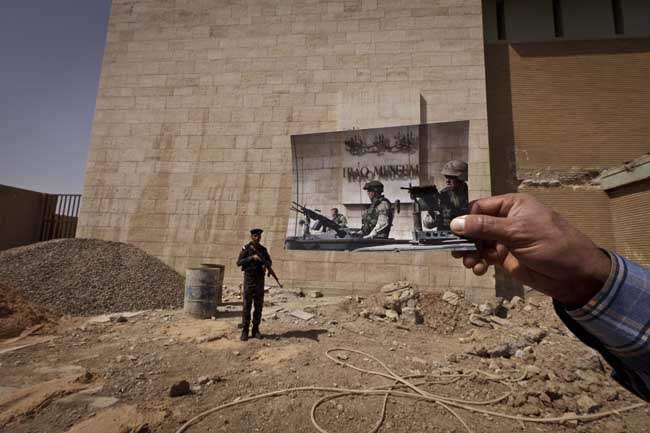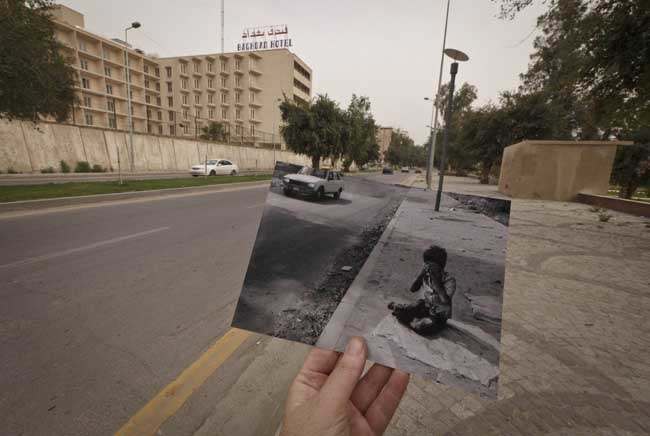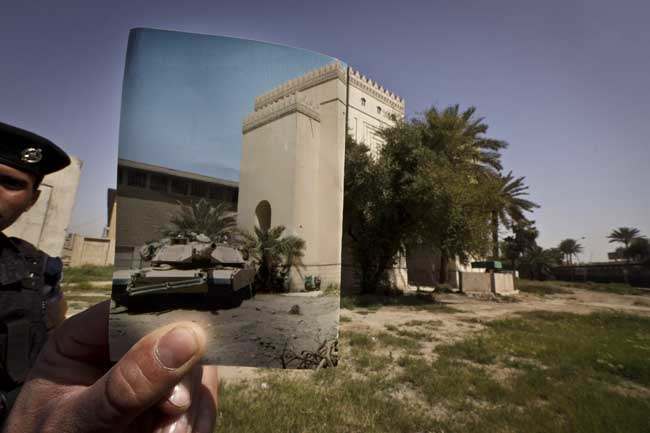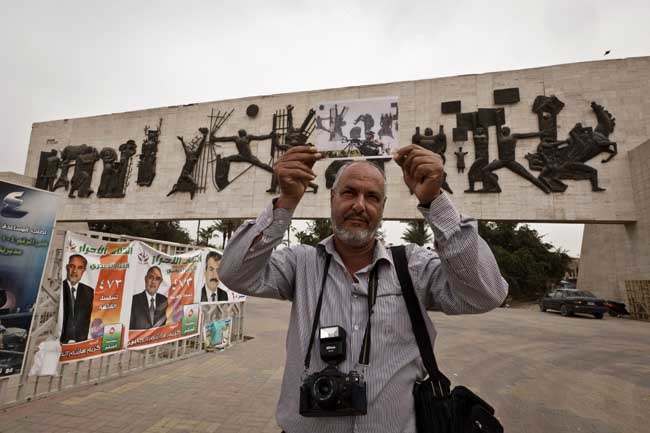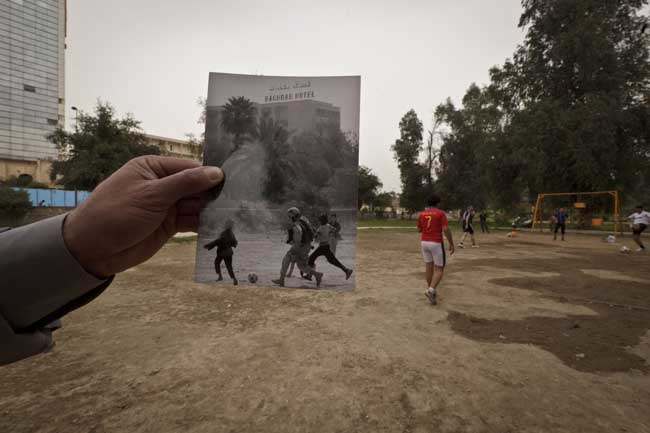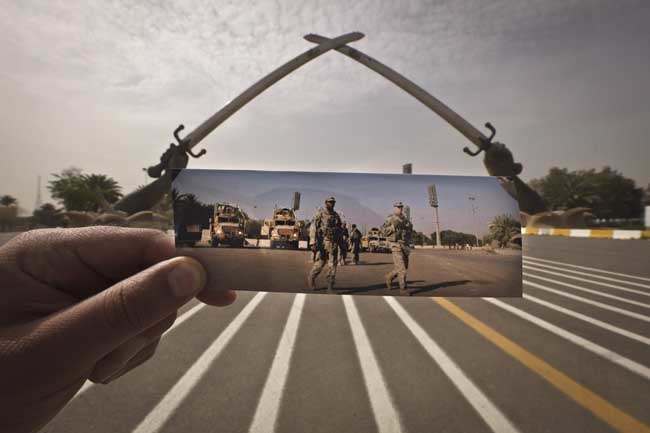ON This Site is a photo essay of what life was like after the 21-days war that was Operation Iraqi Freedom and what it looks like now. Between 19 March 2003 to 1 May 2003, the Iraq War raged. Against a backdrop of duplicitous Western leaders (Tony Blair being the most craven) and Saddam Hussein’s brutality, the US led forces from the United Kingdom, Australia and Poland into Baghdad:
In this Wednesday, March 13, 2013 photo, Iraqi policeman Ahmed Naji stands on the grounds of the Iraqi National Museum at the site of an Associated Press photograph of U.S. soldiers on guard outside the museum taken by Anja Niedringhaus on Nov. 11, 2003. Tens of thousands of artifacts chronicling some 7,000 years of civilization in Mesopotamia are believed to have been looted from Iraq in the chaos which followed the the U.S.-led invasion in 2003. Despite international efforts to track items down, fewer than half of the artifacts have so far been retrieved. (AP Photo/Maya Alleruzzo)
This Tuesday, March 12, 2013 photo shows a general view of Abu Nawas Street in Baghdad, Iraq, at the site of a photograph of Iraqi orphan Fady al-Sadik waking on the street, taken by photographer Maya Alleruzzo in April, 2003. The park that runs along Abu Nawas Street, named for an Arabic poet, is now a popular destination for families who are drawn by the manicured gardens, playgrounds and restaurants famous for a fish called mazgouf. Ten years ago, the park was home to a tribe of children orphaned by the war and was rife with crime.
In this Wednesday, March 13, 2013 photo, Iraqi policeman Ahmed Naji stands on the grounds of the Iraqi National Museum at the site of an Associated Press photograph by Murad Sezer showing a U.S. Army tank parked outside the Iraqi National Museum in Baghdad on Tuesday, May 6, 2003. Tens of thousands of artifacts chronicling some 7,000 years of civilization in Mesopotamia are believed to have been looted from Iraq in the chaos which followed the the US-led invasion in 2003. Despite international efforts to track items down, fewer than half of the artifacts have so far been retrieved.
In this Thursday, March 14, 2013 photo, Hussein, 3, poses in Firdous Square in Baghdad with a photograph taken at the site by Jerome Delay of the Associated Press showing the statue of Saddam Hussein being pulled down by U.S. forces and Iraqis on April 9, 2003. Ten years ago on live television, U.S. Marines memorably hauled down a Soviet-style statue of Saddam, symbolically ending his rule. Today, that pedestal in central Baghdad stands empty. Bent iron beams sprout from the top, and posters of anti-American Shiite cleric Muqtada al-Sadr in military fatigues are pasted on the sides.
In this Saturday, March 16, 2013 photo, street photographer Raad Mohammed poses with a photograph taken by photographer Khalid Mohammed in Baghdad’s Tahrir Square showing an Iraqi soldier manning a checkpoint on Friday, June 9, 2006, after the Iraqi capital was subjected to a vehicle ban in an effort to prevent reprisal attacks from suicide car bombs after the killing of Abu Musab al-Zarqawi. Today, the square is the site of anti-government protests and a place for candidates in the upcoming election to display their campaign posters.
In this Saturday, March 16, 2013 photo, motorists fill the main street in Baghdad’s busy shopping district of Karrada, at the same site of an Associated Press photo taken by Hadi Mizban on Friday, Friday, March 7, 2008 after a bombing that killed 53 people and wounded 130. Bloody attacks launched by terrorists who thrived in the post-invasion chaos are painfully still frequent, albeit less so than a few years back, and sectarian and ethnic rivalries are again tearing at the fabric of national unity.
This Tuesday, March 12, 2013 photo shows a general view of Abu Nawas park in Baghdad, at the site of a photograph taken by Maya Alleruzzo showing Iraqi orphans playing soccer with a U.S. soldier from the Third Infantry Division in April, 2003. The park that runs along Abu Nawas Street, named after an Arabic poet, is now a popular destination for families who are drawn by the manicured gardens, playgrounds and restaurants famous for a fish called mazgouf. Ten years ago, the park was home to a tribe of children orphaned by the war and was rife with crime.
In this Friday, March 15, 2013 photo, a woman and her child look at a camel at the Baghdad Zoo, as Abdullah, 8, poses with a photograph taken on July 20, 2003 at the same site by Niko Price of the Associated Press, showing a U.S. soldier visiting the newly-opened zoo. The zoo was decimated during the 2003 U.S.-led invasion, when the staff fled and looters gutted the zoo and the park surrounding it. Only a handful of animals survived, and later the grounds were used as a holding facility for looters detained by U.S. soldiers. The zoo reopened in July 2003, after being rehabilitated under the care of U.S. Army Capt. William Sumner and a South African conservationist Lawrence Anthony. Today, it houses over 1,000 animals and is a popular destination for families.
This Thursday, March 14, 2013 photo shows a general view of the crossed swords monument at the site of an Associated Press photograph taken by Karim Kadim of U.S. soldiers taken on Nov. 16, 2008. The crossed-sword archways Saddam Hussein commissioned during Iraq’s nearly eight-year war with Iran stand defiantly on a little-used parade ground inside the Green Zone, the fortified district that houses the sprawling U.S. Embassy and several government offices. Iraqi officials began tearing down the archways in 2007 but quickly halted those plans and then started restoring the monument two years ago.
Would you like to support Flashbak?
Please consider making a donation to our site. We don't want to rely on ads to bring you the best of visual culture. You can also support us by signing up to our Mailing List. And you can also follow us on Facebook, Instagram and Twitter. For great art and culture delivered to your door, visit our shop.
